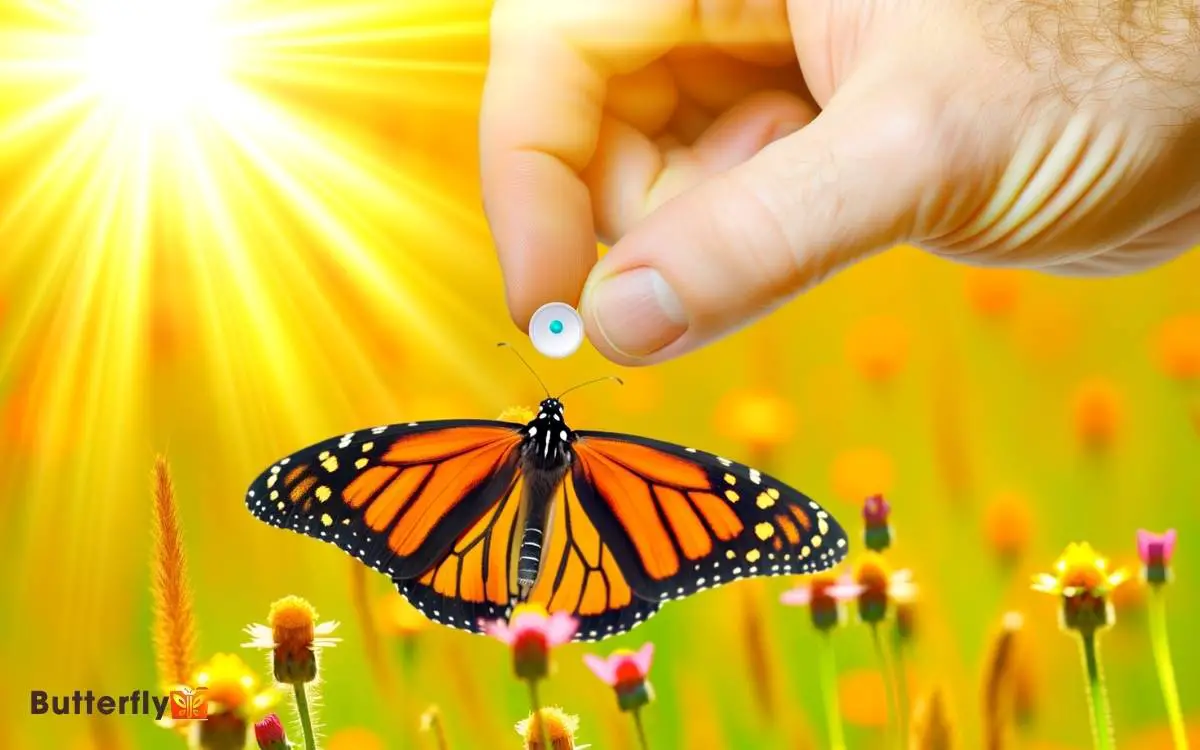How Do You Tag a Monarch Butterfly? Step-by-Step Guide!
To tag a monarch butterfly, start by preparing a specialized tagging kit with lightweight adhesive tags and fine-tipped applicators.
Capture the butterfly gently using a lightweight net. Hold the monarch by its wings and carefully attach the tag to the discal cell of the hindwing. Make sure the tag is secure but doesn’t hinder movement.
Record important data like date, location, and tag number. Release the butterfly in a pesticide-free environment, monitoring for normal flight behavior.
Meticulously report your findings, including the unique tag code and observational data, to contribute to scientific research and conservation efforts.

Key Takeaways
Understanding Monarch Migration
Monarch migration, a remarkable phenomenon, involves millions of butterflies traveling up to 3,000 miles from North America to central Mexico. You’ll find that this journey is driven by environmental cues like temperature changes and daylight duration.
Monarchs utilize a combination of genetic programming and environmental triggers to navigate their long route. They rely on thermal air currents and the Earth’s magnetic field for orientation.
Research indicates that monarchs have specialized sensors in their antennae, which help in detecting these navigational cues.
Observing their roosting patterns in trees during migration provides insights into their resting and energy-saving behaviors.
By understanding these mechanisms, you can appreciate the complexity and precision of monarch migration, laying the groundwork for deeper scientific inquiries.
Importance of Tagging
Tagging plays a crucial role in tracking the migratory patterns and population dynamics of monarch butterflies.
By applying tiny, lightweight tags to the wings of these butterflies, you can gather critical data on their flight paths, stopover sites, and survival rates. This information helps scientists identify key habitats and conservation needs.
Tagging also permits longitudinal studies, allowing you to observe changes in migration timing and routes over multiple years. These data can indicate the impact of climate change, habitat destruction, and other environmental factors.
Additionally, by participating in tagging programs, you contribute to a larger citizen science effort, providing invaluable data that informs conservation strategies and policy-making.
The precision and consistency of this methodology ensure robust, evidence-based conclusions.
Necessary Equipment
To effectively tag a Monarch butterfly, you’ll need a specialized tagging kit that includes adhesive tags, fine-tipped markers, and a data recording sheet.
Make sure you apply the tracking device gently to the discal cell of the hindwing to avoid damaging the butterfly.
Evidence shows this method maximizes tracking efficiency while minimizing harm to the insect.
Tagging Kit Essentials
Before you begin tagging, make sure your kit contains adhesive tags, a soft net, a data sheet, and a fine-tipped marker. Each item is essential for accurate and efficient tagging.
The adhesive tags should be lightweight and durable to not hinder the butterfly’s mobility. Use the soft net to gently capture the butterfly without causing harm.
Make sure your kit includes:
- Adhesive tags: Ensure they’re specifically designed for monarchs.
- Soft net: Opt for one with a long handle for safe capture.
- Data sheet: Record critical data like tag number, date, and location.
A fine-tipped marker is vital for labeling tags if they’re not pre-numbered. This equipment ensures you can tag monarchs scientifically and responsibly.
Tracking Device Application
After assembling your tagging kit, applying the tracking device correctly is the next critical step. Make sure you have a gentle grip on the butterfly to avoid wing damage.
Use a fine-tipped applicator to place the small, lightweight tag on the discal cell of the hindwing. This location minimizes interference with the butterfly’s flight abilities.
| Equipment | Purpose |
|---|---|
| Fine-tipped Applicator | Precise placement of the tag |
| Lightweight Tag | Allows tracking without hindering movement |
| Forceps | Gently handle the butterfly |
Align the tag precisely for accurate tracking data. Research shows this method doesn’t impair the butterfly’s migratory behavior. Always handle with care and precision to ensure the safety and proper tagging of the monarch butterflies.
Finding Monarch Butterflies
Identifying the prime habitats where monarch butterflies thrive is essential for effective tagging and research. Focus on areas where milkweed, their primary larval host plant, is abundant.
Monarchs prefer open fields, meadows, and roadside habitats where milkweed and nectar sources are plentiful.
To find monarchs, you should:
- Survey milkweed-rich locations: Regularly monitor areas with high concentrations of milkweed.
- Track migratory patterns: Use data from citizen science platforms to identify peak migration times.
- Observe weather conditions: Monarchs are more active in warm, sunny weather.
Employing these evidence-based methods will increase your chances of locating monarchs effectively.
Keep detailed records of your observations, as precise habitat data is essential for understanding monarch behavior and enhancing conservation strategies.
Capturing Techniques
To capture monarch butterflies effectively, use a lightweight, long-handled butterfly net with a wide, deep mesh bag. Position yourself near milkweed or flowering plants where monarchs congregate.
Approach slowly, maintaining a low profile to avoid startling them. When a monarch is within reach, swiftly but gently swing the net in an upward arc to enclose the butterfly. Once captured, twist the net’s handle to prevent escape.
Make sure the mesh bag is deep enough to avoid damaging the wings. Conduct captures during cool mornings or late afternoons when butterflies are less active.
This method minimizes harm and maximizes capture efficiency, aligning with evidence-based practices in lepidopterology.
Handling With Care
Once you’ve captured a monarch butterfly, handle it with utmost care to avoid damaging its delicate wings and body. Monarchs are fragile, and improper handling can lead to injury.
Follow these steps to make safe handling:
- Use a gentle grip: Hold the butterfly by its thorax, between the wings, using your thumb and forefinger.
- Minimize wing contact: Touch the wings as little as possible to prevent removing the scales that are essential for flight.
- Work quickly and efficiently: Prolonged handling increases stress on the butterfly and risks injury.
Applying the Tag
Carefully place the small, circular tag on the discal cell of the monarch’s hindwing, ensuring it adheres firmly without obstructing the veins. This specific location minimizes interference with the butterfly’s flight mechanics.
Use forceps to handle the tag, applying gentle pressure to secure it. Confirm the adhesive is effective by pressing down for a few seconds. Avoid touching the tag with your fingers to prevent contamination and guarantee ideal adhesion.
Verify the tag is centered and properly aligned on the discal cell. If the tag appears loose, replace it with a new one. Proper application of the tag is essential for accurate tracking and data collection.
This methodology is supported by extensive research and field studies.
Recording Data
After tagging the monarch butterfly, accurately document the unique tag code, date, and location of tagging in your field notebook or digital database. This detailed record-keeping is essential for tracking the butterfly’s migration and survival rates.
Make sure you also record the butterfly’s sex and wing condition to provide thorough data.
- Tag Code: Note the specific alphanumeric code on the tag.
- Date and Location: Record the exact date and GPS coordinates of tagging.
- Butterfly Characteristics: Include details like sex, wing integrity, and any notable markings.
Releasing the Butterfly
Gently hold the butterfly by its wings and position it in an open, sunny area to optimize its flight initiation. Make sure minimal handling to prevent wing damage.
The ideal temperature for release is above 55°F (13°C), as butterflies are ectothermic and require warmth for muscle function. Open your hand slowly, allowing the butterfly to acclimate. Observe its initial flight; a healthy monarch will demonstrate strong, directed movement.
Avoid releasing in windy or rainy conditions, which can impair flight and increase predation risk. Document the release time, weather conditions, and butterfly behavior. This data contributes to migration and population studies, providing valuable insights.
Release in a pesticide-free environment to support survival and successful migration.
Reporting Your Findings
After tagging and releasing your monarch butterfly, you should report your findings using established data submission methods. Contact research organizations to verify that your data contributes to ongoing scientific studies.
Be meticulous in sharing observation details, including date, location, and tag number, to support accurate data analysis.
Data Submission Methods
To report your findings, submit the tag data through the Monarch Watch website, ensuring accurate entry of each butterfly’s unique tag code and corresponding details. Precise data recording is essential for robust research outcomes.
Follow these steps meticulously:
- Log the Tag Code: Enter the unique alphanumeric tag code for each monarch.
- Document Capture Details: Record the date, location (latitude and longitude), and condition of the butterfly.
- Submit Observations: Include any relevant behavioral notes or environmental conditions.
Accurate data submission facilitates the tracking of monarch migration patterns and survival rates, contributing greatly to conservation efforts.
Contacting Research Organizations
When reporting your findings, directly contact research organizations such as Monarch Watch to provide your meticulously recorded data and observations.
Make sure you include critical variables like:
- Tag ID
- Date
- Location (latitude/longitude)
- Sex of the butterfly
- Any specific behaviors noted
Use their preferred communication channels, typically email or online submission forms, for accuracy and efficiency.
Double-check your data for completeness and accuracy before submission. Incorporate photographic evidence if possible, as it can validate your observations.
Sharing Observation Details
Sharing your monarch butterfly observations begins with accurately documenting each detail to guarantee the data’s reliability and usefulness.
You’ll need to record:
- Date and Time: Note the exact date and time when you tagged the butterfly. This helps in tracking migration patterns.
- Location: Provide precise GPS coordinates or a detailed description of the tagging site. This information is crucial for mapping their migratory routes.
- Tag Information: Include the unique tag number and any other relevant identifiers.
Submit your findings to a recognized research organization. They use this data to monitor and analyze monarch populations, migration trends, and environmental impacts.
Ensure your observations are meticulously recorded and promptly reported to contribute to the collective scientific effort. Your data helps inform conservation strategies and enhances our understanding of monarch ecology.
Conclusion
By tagging a monarch butterfly, you’ve added a single stitch to the vast quilt of scientific knowledge.
By following precise methods and using the right equipment, you’ve contributed valuable data. Your meticulous work aids in understanding these remarkable insects’ migration patterns.
Be sure to report your findings to further enrich this collective effort. Each tagged butterfly is a data point, a clue in the larger mystery of migration, helping scientists uncover the secrets of their epic journeys.






